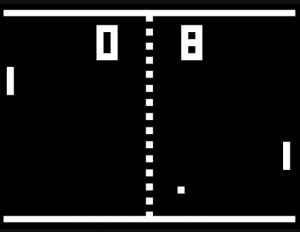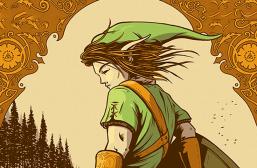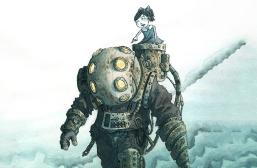Indie Game Development: An Art of its Own
In one sense, video games came into existence when they were first created.On the contrary, video games as a cultural revolution did not share the same starting point as their first inception, but originated when they first gained status in the community. For something to truly come to substance, it must first become known and then experienced. In this respect Pong was the first video game, as many had come to know and play it. It was on the path carved by Pong that video games began a journey of evolution.

What began as pixels traversing a screen became pixels with purpose. Gameplay began to define games and differentiated one from another. Then came art, unique sprites and characters players could associate with a particular game. A game’s aesthetics and controls were then merged with a storyline, giving players a reason to care about these characters, driving them to partake in their worlds. As time progressed, stories became more elaborate, and in line with the technological advances of technology, character models and the art of games became more elaborate as well, making the characters more realistic than they had been. Webster defines art as something that is created with imagination and skill, that is beautiful or that expresses important ideas or feelings. Art evolves with humans, as human potential is always growing. Whether be it musical, visual, or literary art, there is always new innovation that changes the art form. As a form of entertainment, video games by nature are works of art. However many of the unique qualities are lost through the mainstream production of games. Larger companies are obligated to keep sales numbers high so they tend to recycle formulas that work. As a result of reused mechanics and similarities, many games seem tired and washed up. It is because of this trend that independent game developers have become so successful in the most recent years as they have been able to break this cycle and bring back the special qualities games had.
The Art of Video Games
Art is forever changing with the times. The mediums of art have progressed from painting to motion pictures. In order to define a video game as art, a standard definition for art must be properly defined so that it may be related to works of art across all mediums. In “Will Computer Games Ever Be a Legitimate Art Form?” by Earnest Adams, he notes that in the twelfth century, the notions of art moved from art as a perfect representation to art being an expressive representation of the artist. This allowed for more expressive art forms, such as music or dance, to be included in the larger category of art. Through its expressive nature, art is able to create a dialogue between the viewer and the artist. In this sense, video games uses its interactive nature to create this dialogue. However, Adams states that when the viewer begins to interfere with the art, the original message intended by the artist is lost. Video games are able to overcome this as they contain dynamic narratives that rely on input from the player. For example, in the Indie title “Proteus”, there is no dialogue or plot in the game, so communication between the player and developer is solely dependent on the interactions with the in-world props. The player can move around the procedurally generated world freely, exploring and watching as the animals run and jump upon approach. Additionally, the music in the soundtrack changes depending on the players surroundings. This is best seen in Proteus after a season change occurs. During the spring, the player is greeted by bright colors, a light soundtrack, and the lively animals whereas in the winter, we see paled colors, little to no animal life, and a soundtrack that isn’t so upbeat.

Indie and AAA Development
AAA development is a term used to describe something that is made with a higher quality than most products. Indie games usually carry the connotation that they were made by a smaller studio. In some contexts, these definitions would suffice but in the argument of art, they will have to be revised. Nadav Lipkin realizes this in his article, “Examining Indie’s Independence”, when he must clearly separate Indie from AAA, as some Indie studios make games of high quality whereas some Indie studios do not have the same intentions as most independent studios. He uses the independent company, Zynga, as an example as they prioritize making money over creative vision. In order to separate the two properly in this context, the politics behind the production of the product are the determinants in the classification of a studio as an Indie studio or a mainstream AAA studio.

In the documentary “Indie Game: The Movie”, Indie developer Jonathan Blow says “Part of it is about not trying to be professional…What those game companies do is create highly polished things that serve as large of an audience as possible…That creation of this highly glossy commercial product is the opposite of making something personal.” Indie culture, by its nature, has always been opposite of mainstream. We see these trends in independent music artists and at independent film festivals where the general themes go against what mainstream media is trying to accomplish. The Indie agenda is not focused on appeasing large amounts of people, but on creating a unique and expressive product for those who would appreciate it. This is where the separation lies.
The Art of Indie
Independent publishers do not have the resources that large developers have. In “Indie Game: The Movie”, Team Meat only had two developers, Tommy and Edmund, and they were one of the larger teams. These developers do not have much funding either. The reason why they continued to develop Super Meat Boy was simply due to their want to create. Edmund reiterates the use of communication through his games as a way of relating to other people. Throughout the documentary, this seemed to be a reoccurring theme with the developers, communication. Whether it is communication through the gameplay or communication through storytelling, Indie games have had a subtle way of rubbing players in the right ways. For example, Super Meat Boy was one of the largest Indie successes to date. It is most notable for it’s fast-paced gameplay and its unforgiving difficulty. One of the strongest portions about this game is its underlying imagery. If you look at Meat Boy, he seems to just be red and made of meat. However, the developer states that Meat Boy is actually a boy without skin. Throughout the game, he is collecting bandages and is constantly chasing after his girlfriend, Bandage Girl. Though players may simply be drawn to the game simply because of the challenges it provides, the relationship between Meat Boy and Bandage Girl is a force in its own. Meat Boy needs her. He is not just a boy made of meat, but a boy without skin. Without the protection Bandage girl provides, he is completely vulnerable. It’s not just a story about another damsel in distress; the one in distress is Meat Boy.

The Current State of Indie
As current trends reflect, Indie games have been top dog on the market place for some time now, beating out some of the stronger AAA releases, showing they aren’t going anywhere for a while. Indie games are becoming competitive on the gaming front and AAA developers are trying to follow the trend they are setting. Indie games have created a culture around themselves with unique forms of storytelling and a strong communication with the player. This is one of the main reasons why games are so captivating to players. As an art form, video games in general have succeeded in creating an immersive environment for players. Mainstream games have created narratives that have hoarded the masses yet they continuously recycle elements in as though they are trying to stick with what they know in order to secure revenue and ensure that they will always have a solid fan base. It is these limiters that separate Indie games from the rest.
While AAA games try to become perfect products for the masses, Indie games have nothing to lose. Flaws in Indie games are what make them unique, as no human is perfect, and that is what Indie games are: human. They are relatable in the messages send to players, and they are a breath of fresh air in a sea of similarities. Because of this, Indie games have not only received the respect that they have earned, but have been placed in high regards in the art community. Look around the Internet for a while and you can find an Indie game on almost every gaming messaging board and forum. People are not solely talking about the game and how it plays, people are debating over these games as they would over any works of art. There are thousands of players deciphering the messages that these games have weaved deep down.
Art, by definition, is something that is created with imagination and skill, that is beautiful or that expresses important ideas or feelings. Art evolves with humans, as human potential is always growing. Whether be it musical, visual, or literary art, there is always new innovation that changes the art form. Video games have earned their spot as art, however not all art is good. With recycled mechanics and tired plots, the colors that games originally had have become grayed and dulled. However, in the nature carried by the word “independent”, some of these smaller Indie game companies have found the colors that players have long forgotten and have brought back in new ways the life games used to have. It is in their unique storytelling, gameplay mechanics, and the personal connections that Indie games make with the player that they have been able to separate themselves from the average art style that video games have become and emerge as something truly remarkable: an art of it’s own.
Works Cited
Adams, E. W. (2006). Will Computer Games Ever Be a Legitimate Art Form? Journal of Media Practice , 7 (1), 67 -77.
Pajot, L., & Swirsky, J. (Directors). (2012). Indie Game: The Movie [Motion Picture].
Gee, J. P. (2006). Why Game Studies Now?: Video Games: A New Art Form. Sociological Abstracts™ , 1 (1), 58-61.
Juul, J. (2005). Half-Real: Video Games between Real Rules and Fictional Worlds. Cambridge, Massachusetts: The MIT Press.
Lipkin, N. (2012). Examining Indie’s Independence: The Meaning of “Indie” Games, the Politics of PRoduction, and Mainstream Co-optation. Journal of the Canadian Game Studies Association , 7 (11), 8-24.
What do you think? Leave a comment.











I always found video games to be an art form which offers something other kinds of art can’t: interaction.
That’s not entirely true – theatre and performance art both use interactivity to a certain extent. Indeed the “happenings” of the sixties and seventies were driven by this point, to bring art out of galleries and make a visceral, two way connection between the “artist” and the “audience”. In many ways this is the same space games exist when they choose to be art. The artist creates the space, and the setting, but what happens in that space is largely down to the audience. The art is in the audience’s reaction to the situation. For example, look at Marina Abramovic’s “The Artist Is Present”. In that piece, the art is not in a woman sitting at a table, but in the head of the audience member sitting opposite.
Good article, it’s always nice to see a fan of indie video games share their passion.
Thanks, I’m really happy you enjoyed the article! Indie games are by far my favorite types of games.
If you designed a game that could only be shown in an Art Gallery and no one was allowed to play it, would that make it Art? The fact that people can interact with games in their own homes does not mean that it cannot be art. Art at its core is basically visual communication.
I guess the issue is whether the experience of playing a game could be construed as art. Whatever you may think of how advanced games are nowadays in terms of their ideas, they still are ultimately linear – they provide you with a limited number of options and goals with which to advance. The whole point of gaming is to solve problems, defeat opponents – and that’s the crux.
I prefer boardgames to computer games nowadays because I think the design of some of them are much more compelling – and I think you could argue that there is art in them. Reinier Kniza, Antoine Bauza, Sid Sackson, Martin Wallace – these designers produce elegant games with very little apart from a board, some cubes and a rule book.
If a game speaks to you though, evokes thoughts, feelings, emotions then who are critics, or you for that matter, to tell them that they are responding to non-art.
You bring up board games, what would you say about Chess? about Go? I’m sure that chess lovers across the world would agree that there is an art and beauty to the way the game can be played.
Almost any kind of narrative form is ‘linear’ to a certain degree, though.
I’ve recently crossed that particular nerdy rubicon and have started to enjoy boardgames too; Twilight Struggle, a two-player history-fest in which you play as either the US or USSR, vying for influence during the Cold War, really is brilliant.
I do see what you are saying, and playing a game is just another part of the art form. As you said, many games are very linear, but in reality, even open world games have this limitation, but it is not a restriction. Storytelling in games works in many different ways. Using a linear storyline helps to focus players in cases where the developer would rather focus on the story and that point in the universe. In open world games, players are encouraged to explorer and complete quest that will allow them to learn more about the world and become a part of it. All the other aspects of the game really exist to keep the player entertained while progressing through the story. The best examples of this are games like Skyrim where you’re given a small amount of backstory and then released you into the world to explore. Most of the game’s content is enjoyed when you’re in dungeons exploring, finding artifacts, and then learning about the lore behind the them. These games also create immersion by taking advantage of player interactions with the NPCs through side quests or hearing their conversations in passing. Some linear games Half Life 2 would have you learn about the universe by taking placing you smack in the middle of a conflict. There are some games that find a comfortable medium like Dishonored and Mass Effect where you can participate in a fair amount of exploration but you are always gravitating forward in the story.
I can see where you’re coming from. Over the last two years, I have been exposed to the world of tabletop RPGs, and it is glorious. There’s nothing like spending a few hours with your friends playing through a good Call of Cthulhu scenario. There’s so much freedom in these kinds of games, as they almost entirely rely on the imagination of the players to create a world. It leaves a lot of room for open interpretation, even for scenarios that have already been written out. Being able to lose yourself in that world is an amazing experiences, even for people like me who are only completed a few scenarios.
In the end all games are art in some way but the way we interpret our experience will change how effective it was in creating good communication. That will ultimately separate a game from art.
Art is synthesis which illuminates the human condition.
Indie games are made with love, passion and enthusiasm by teams of hard working people. They iterate and push boundaries to entertain, impress and amaze.
Games developers love making games and gamers love playing them. Nothing else matters.
Computer games have some breathtaking art in them, and some of the writers of storylines are fantastic (Even though most people just click through the quest text to get to the splatting mobs).
Anyone arguing against the validity of video games as a legitimate art form need look no further than Shadow of the Colossus or Ico. They prove video games can transcend their medium into something greater, and truly beautiful.
Aww man, SotC and Ico are such great games! That remaster for the PS4 was the first game I bought. Not only were they aesthetically beautiful, but the stories for both games were amazing. Even now I still play the games or have people come over to give them a try.
Interesting article. Are games art is a neverending discussion. Part of the problem, IMO, is that no simple term exists to distinguish between “pure fun” video games and those that strive to be something more. This is unlike other artistic media, e.g. there are comics and there are graphic novels, there are blockbuster movies and there are arthouse flicks, there are cartoons and there are animated films etc. It just doesn´t help the debate to have games like Call of Duty and Dear Esther to be sitting side by side in a single, catch-all “videogame” category.
This is a very interesting topic, addressing the notoriously difficult question: what is art. One of the main points in your article is the definition of art and how such a definition is necessary if we are going to compare one art form from another or even compare one “piece” of art against another in the same genre (video games, in your article, but it could just as well be a comparison of works of literature, painting, music, etc.).
What I find striking is the fact that in the article by Ernest Adams that you cited, he says fairly clearly that video games are not art: “I assert that the vast majority of what the game industry does is not art, but popular culture.” I take I the you disagree with this stance – it is based on a conception of art where the artist creates some work and then the viewer or listener takes in that work, is sort of a passive receptacle for that work of art. This is an ancient view of art and, in my view, either outright wrong or seriously limiting. I think it’s the good fortune of video games, as you say, they are interactive and demand from the “viewer,” in this case the player, active participation.
I teach at a small college main objective is to teach students the digital arts, whether it be video games, music, film, or animation. From teaching many classes, and discussing this sort of thing with my students, I have no doubt that they believe that they are creating art. It isn’t even a question – they are learning the digital arts and they consider themselves to be artists.
And what I find refreshing, contra Ernest Adams, is that what they define as art is all of those things Adams states are necessary for art to be art: “Art is purchased in art galleries by art connoisseurs, it is criticized by art critics, it is conserved in art museum. It is not sold in toy shops.” To me, this the kind of notion I mentioned above, where art is some sort of object to be enjoyed only by those in the know (connoisseurs), sold in an art gallery, conserved in a museum.” This is simply outdated at best, wholly incorrect at worst.
I think of it as akin to Jean Dubuffet’s turn to “Art Brut,” that only in Art Brut “can we find the natural and normal processes of artistic creation in their pure and elementary state.” And for Dubuffet, this meant art created by non-professionals – Indie game developers. Art should not be about who can sell what painting for however much money, should not be created in order to show in a gallery, and not produced to be conserved in a museum. This is actually the antithesis of art.
That’s why your take on the nature of Indie game developers in important – it shows that we do not have to adhere to some silly or random rule somebody or other made up about what art is. And Indie game developers, as my students would tell you, don’t give a hoot about some pallid definition of art. As for as they are concerned, what they are actually doing is art.
You’re a great writer, Moseff. You have a lot of great lines in this piece that are aesthetically pleasing and really drive your point home. Your conclusion rocks and this whole article really supports your argument. A+ my friend, a fabulous read!
Ahhh, thanks Mary, I really appreciate that!!
I consider video games to be a type of art as well. Indie games, although they tend to have lower quality, are popular and fun. Especially among me and my friends. It only takes the interest of one person for an indie games to gain reputation. Great article.
Interesting article! Indie games are an art, a unique one at that. Some of my favorite recent ones are The Cat Lady, Starbound, The Vanishing of Ethan Carter, Valiant Hearts: The Great War. Indie games are more personal, and overall have a better story then most AAA games. If it puts me in tears, you bet I will support the developer 100% of the way.
Interesting article! Indie games are a work of art, a unique one at that. Some of my favorite recent ones are The Cat Lady, The Vanishing of Ethan Carter, Starbound, and Valiant Hearts: The Great War. Indie games provide an intriguing story that a AAA game has never produced in my eyes. If I burst out in tears, no doubt I will be behind the developer 100%!
I do find that a lot of Indie games bring something new to the table. Take Minecraft for example. It started out as an Indie sandbox game, which brought the nostalgic 8-bit textures back to video games, as every other game is focusing on sharpening the graphics for more visual appeal. It’s one reason why I love Indie games. The creativity is merely endless from these developers and their games always look interesting.
I think what makes indie games stand out from the crowd is the raw edges the creator has put into it, and sometimes a video games needs that raw edge. For example, I am currently waiting on Super Chibi Knight to premiere on Steam. Based on the screenshots i know the game doesn’t have killer graphics or an expansive plot /story-line but what it has is something mainstream video games lack. An independent soul. Video game companies try to appeal to a mass audience and do not always respect the wishes of the creator and eventually filter out many unsavory parts of a video game just to please a bigger crowd in hopes getting a bigger paycheck.
It is nearly impossible to respect the wishes of everyone, and video game companies know that better than anyone else. That’s why they choose to follow the wishes that would give them the bigger paycheck, essentially ignoring the smaller audience. This is where indie game developers come in. There is a niche market that do not buy into new world games that lack the authenticity indie gamers want, and that niche market consists of probably nostalgic gamers like me who crave an uncensored/unfiltered/undefined game that may or may not have the best graphics but has a soul that resonates with us.
Whatever these indie game developers are doing, they’re doing it right.
Whether or not there is interaction within the game, there is still the visual and auditory sections of the game which make it beautiful. A video game without interaction is basically just a movie, which is considered art.
FTL (Faster Than Light) is easily my favorite indie game ever. I highly recommend it if anyone likes rogue-type space games. It incorporates strategy and has a wonderful soundtrack. Give it a shot!
Nice article. It is art. And we are getting to a place where it is admired as such, but it is art that transcends business as well. Cool thoughts man!
This is a topic that is very dear to me and one that I find is becoming increasingly relevant as the years go on. However I think that it is hampered by the attempts by many to define what art is.
Speaking from my own experience art is a largely subjective medium, and the skill involved in its production varies. A colour field painting is something that requires a lower level of painterly skill than a realist work, yet the art community largely considers both to be art (though many still dispute the former). If we are to consider videogames artworks based on the level of skill involved in their production then it opens up some games to a form of criticism that I don’t think they deserve.
A game can use pre-made art assets to flesh out its environments, or even be made entirely from a map editor. In terms of aesthetic skill one could say they are lacking, but the fact remains that a certain passion went into their construction. There are certainly games that abuse these resources in order to make a quick buck, but that’s not exactly new in the history of art. Hopefully as we discuss more about the topic our understanding of what constitutes art can simultaneously broaden.
Great article. I love well-made and inventive indie games. You can tell when the creator(s) put a lot of work in creating the narrative and sustaining a compelling setting.